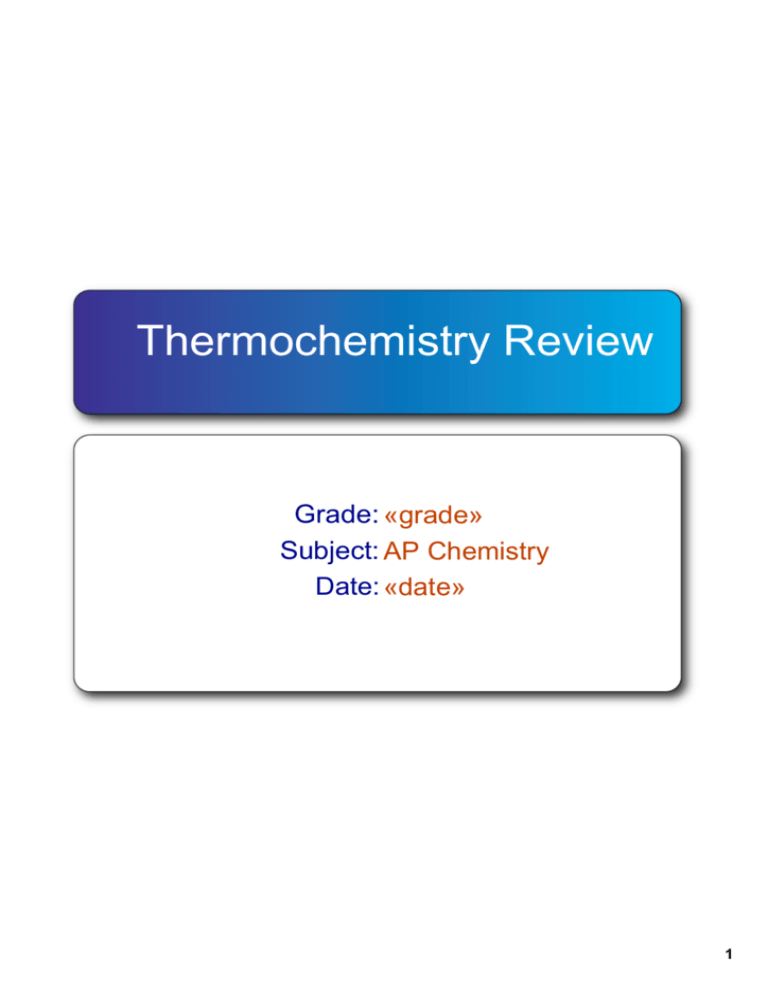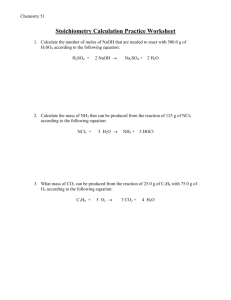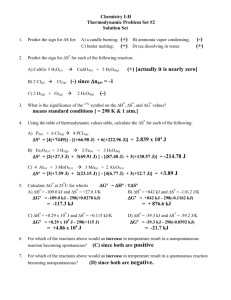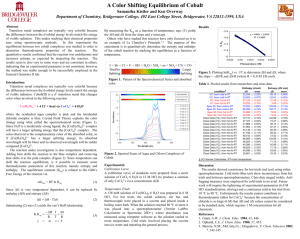Thermochemistry Review
advertisement

Thermochemistry Review Grade: «grade» Subject: AP Chemistry Date: «date» 1 1 1. CH4(g) + 2 O2(g) g CO2(g) + 2 H2O(l); H= ­ 889.1 kJ Hf° H2O(l) = ­ 285.8 kJ / mole Hf° CO2(g) = ­ 393.3 kJ / mole What is the standard heat of formation of methane, Hf° CH4 (g), as calculated from the data above? A ­210.0 kJ/mole B ­107.5 kJ/mole C ­75.8 kJ/mole D 75.8 kJ/mole E 210.0 kJ/mole 2 2 H° = x H2(g) + 1/2 O2(g) g H2O(l) 2 Na(s) + 1/2 O2(g) g Na2O(s) H° = y Na(s) + 1/2 O2(g) + 1/2 H2(g) g NaOH(s) H° = z Based on the information above, what is the standard enthalpy change for the following reaction? Na2O(s) + H2O(l) g 2 NaOH(s) A x + y + z B x + y ­ z C x + y ­ 2z D 2z ­ x ­ y E z ­ x ­ y 3 3 C2H4(g) + 3 O2(g) g 2 CO2(g) + 2 H2O(g) For the reaction of ethylene represented above, H is ­ 1,323 kJ. What is the value of H if the combustion produced liquid water H2O (l), rather than water vapor H2O(g)? ( H for the phase change H2O(g) g H2O(l) is ­44 kJ mol­1.) A ­1,235 kJ B ­1,279 kJ C ­1,323 kJ D ­1,367 kJ E ­1,411 kJ 4 4 A cube of ice is added to some hot water in a rigid, insulated container, which is then sealed. There is no heat exchange with the surroundings. What has happened to the total energy and the total entropy when the system reaches equilibrium? Energy Entropy A Remains constant Remains constant B Remains constant Decreases C Remains constant Increases D Decreases Increases E Increases Decreases 5 5 Which of the following must be true for a reaction that proceeds spontaneously from initial standard state conditions? A ΔG° > 0 and Keq > 1 B ΔG° > 0 and Keq < 1 C ΔG° < 0 and Keq > 1 D ΔG° < 0 and Keq > 1 E ΔG° = 0 and Keq = 1 6 6 H2O(s) g H2O(l) When ice melts at its normal melting point, 273.16 K and 1 atmosphere, which of the following is true for the process shown above? A ΔH < 0, ΔS > 0, ΔG > 0 B ΔH < 0, ΔS < 0, ΔG > 0 C ΔH > 0, ΔS < 0, ΔG < 0 D ΔH > 0, ΔS > 0, ΔG > 0 E ΔH > 0,ΔS > 0, ΔG < 0 7 7 For which of the following processes would ΔS have a negative value? A I only B I and II only C I and III only D II and III only E I, II, and III I. 2 Fe2O3(s) g 4 Fe(s) + 3 O2(g) II. Mg2+ + 2 OH¯ g Mg(OH)2(s) III. 3H2(g) + 3 C2H4(g) g 3 C2H6(g) 8 8 N2(g) + 3 H2(g) g 2 NH3(g) The reaction indicated above is thermodynamically spontaneous at 298 K, but becomes nonspontaneous at higher temperatures. Which of the following is true at 298 K? A ΔG, ΔH, and ΔS are all positive. B ΔG, ΔH, and ΔS are all negative C ΔG and ΔH are negative, but ΔS is positive. D ΔG and ΔS are negative, but ΔH is positive. E ΔG and ΔH are positive, but ΔS is negative. 9 9 When solid ammonium chloride, NH4Cl(s) is added to water at 25 °C, it dissolves and the temperature of the solution decreases. Which of the following is true for the values of ΔH and ΔS for the dissolving process? ΔH ΔS A Postive Positive B Positive Negative C Positive Equal to zero D Negative Positive E Negative Positive 10 10 Of the following reaction, which involves the largest decrease in Entropy? A CaCO3(s) g CaO(s) + CO2(g) B 2 CO(g) + O2(g) g 2 CO2 (g) C Pb(NO3)3 (aq)+ 2 KI (aq)g PbI2 + 2 KNO3 D C3H8(g) + O2(g) g 3 CO2(g) + 4 H2O(g) E 4 La(s) + 3 O2 (g) g 2 La2O3 (s) 11 ANSWERS 1. C 2. D 3. E 4. C 5. C 6. E 7. D 8. B 9. A 10. E 12








